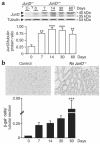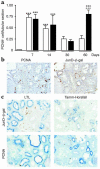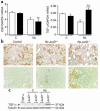JunD protects against chronic kidney disease by regulating paracrine mitogens
- PMID: 12975469
- PMCID: PMC193664
- DOI: 10.1172/JCI17647
JunD protects against chronic kidney disease by regulating paracrine mitogens
Abstract
The AP-1 transcription factor, composed of Jun and Fos proteins, plays a crucial role in the fine tuning of cell proliferation. We showed previously that AP-1 complexes are activated during the proliferative response that parallels the development of renal lesions after nephron reduction, but little is known about the specific role of individual Jun/Fos components in the deterioration process. Here we used JunD knockout (JunD-/-) mice and an experimental model of chronic renal injury (75% nephron reduction) to explore the role of JunD. Nephron reduction resulted in an initial compensatory growth phase that did not require JunD. JunD, however, was essential to inhibit a second wave of cell proliferation and to halt the development of severe glomerular sclerosis, tubular dilation, and interstitial fibrosis. We show that the effects of junD inactivation are not cell autonomous and involve upregulation of the paracrine mitogen, TGF-alpha. Expression of a transgene (REM) encoding a dominant negative isoform of the EGFR, the receptor for TGF-alpha, prevented the second wave of cell proliferation and the development of renal lesions in bitransgenic JunD-/-/REM mice. We propose that JunD is part of a regulatory network that controls proliferation to prevent pathological progression in chronic renal diseases.
Figures





Similar articles
-
JunD attenuates phenylephrine-mediated cardiomyocyte hypertrophy by negatively regulating AP-1 transcriptional activity.Cardiovasc Res. 2006 Jul 1;71(1):108-17. doi: 10.1016/j.cardiores.2006.02.032. Epub 2006 Mar 7. Cardiovasc Res. 2006. PMID: 16690042
-
Jun and JunD-dependent functions in cell proliferation and stress response.Cell Death Differ. 2010 Sep;17(9):1409-19. doi: 10.1038/cdd.2010.22. Epub 2010 Mar 19. Cell Death Differ. 2010. PMID: 20300111
-
Functional cooperation between JunD and NF-kappaB in rat hepatocytes.Oncogene. 2001 Aug 23;20(37):5132-42. doi: 10.1038/sj.onc.1204678. Oncogene. 2001. PMID: 11526502
-
[Cellular proliferation and apoptosis in the development and progression of renal diseases:pharmacological interventions in genetically modified animals].Ann Pathol. 2000;20 Suppl:S3-5. Ann Pathol. 2000. PMID: 11261294 Review. French. No abstract available.
-
Jun signalling in the epidermis: From developmental defects to psoriasis and skin tumors.Int J Biochem Cell Biol. 2006;38(7):1043-9. doi: 10.1016/j.biocel.2005.11.011. Epub 2005 Dec 20. Int J Biochem Cell Biol. 2006. PMID: 16423552 Review.
Cited by
-
Increased renal iron accumulation in hypertensive nephropathy of salt-loaded hypertensive rats.PLoS One. 2013 Oct 8;8(10):e75906. doi: 10.1371/journal.pone.0075906. eCollection 2013. PLoS One. 2013. PMID: 24116080 Free PMC article.
-
Transplant-induced reactivation of murine cytomegalovirus immediate early gene expression is associated with recruitment of NF-κB and AP-1 to the major immediate early promoter.J Gen Virol. 2016 Apr;97(4):941-954. doi: 10.1099/jgv.0.000407. Epub 2016 Jan 20. J Gen Virol. 2016. PMID: 26795571 Free PMC article.
-
Computational Analysis Reveals Distinctive Interaction of miRNAs with Target Genes in the Pathogenesis of Chronic Kidney Disease.Genes (Basel). 2023 Apr 12;14(4):898. doi: 10.3390/genes14040898. Genes (Basel). 2023. PMID: 37107656 Free PMC article.
-
Induced JunD in intestinal epithelial cells represses CDK4 transcription through its proximal promoter region following polyamine depletion.Biochem J. 2007 May 1;403(3):573-81. doi: 10.1042/BJ20061436. Biochem J. 2007. PMID: 17253961 Free PMC article.
-
The role of the EGF family of ligands and receptors in renal development, physiology and pathophysiology.Exp Cell Res. 2009 Feb 15;315(4):602-10. doi: 10.1016/j.yexcr.2008.08.005. Epub 2008 Aug 19. Exp Cell Res. 2009. PMID: 18761338 Free PMC article. Review.
References
-
- Hostetter TH. Progression of renal disease and renal hypertrophy. Annu. Rev. Physiol. 1995;57:263–278. - PubMed
-
- Terzi F, et al. Subtotal but not unilateral nephrectomy induces hyperplasia and protooncogene expression. Am. J. Physiol. 1995;268:F793–F801. - PubMed
-
- Kliem V, et al. Mechanisms involved in the pathogenesis of tubulointerstitial fibrosis in 5/6-nephrectomized rats. Kidney Int. 1996;49:666–678. - PubMed
-
- Terzi F, et al. Sodium restriction decreases AP-1 activation after nephron reduction in the rat: role in the progression of renal lesions. Exp. Nephrol. 2000;8:104–114. - PubMed
Publication types
MeSH terms
Substances
LinkOut - more resources
Full Text Sources
Other Literature Sources
Medical
Molecular Biology Databases
Research Materials
Miscellaneous

